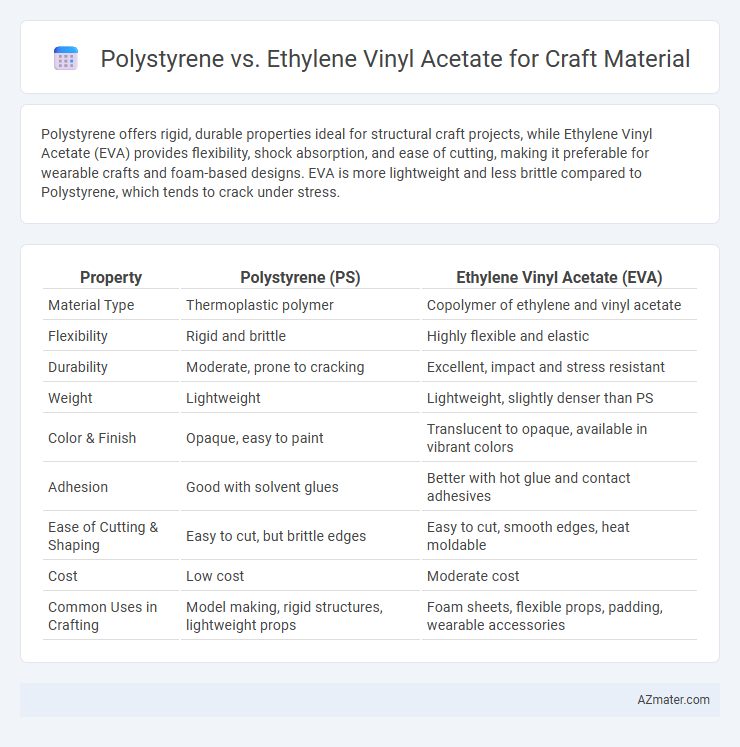Polystyrene offers rigid, durable properties ideal for structural craft projects, while Ethylene Vinyl Acetate (EVA) provides flexibility, shock absorption, and ease of cutting, making it preferable for wearable crafts and foam-based designs. EVA is more lightweight and less brittle compared to Polystyrene, which tends to crack under stress.
Table of Comparison
| Property | Polystyrene (PS) | Ethylene Vinyl Acetate (EVA) |
|---|---|---|
| Material Type | Thermoplastic polymer | Copolymer of ethylene and vinyl acetate |
| Flexibility | Rigid and brittle | Highly flexible and elastic |
| Durability | Moderate, prone to cracking | Excellent, impact and stress resistant |
| Weight | Lightweight | Lightweight, slightly denser than PS |
| Color & Finish | Opaque, easy to paint | Translucent to opaque, available in vibrant colors |
| Adhesion | Good with solvent glues | Better with hot glue and contact adhesives |
| Ease of Cutting & Shaping | Easy to cut, but brittle edges | Easy to cut, smooth edges, heat moldable |
| Cost | Low cost | Moderate cost |
| Common Uses in Crafting | Model making, rigid structures, lightweight props | Foam sheets, flexible props, padding, wearable accessories |
Introduction: Comparing Popular Craft Materials
Polystyrene offers rigidity and durability suitable for structural craft projects, while Ethylene Vinyl Acetate (EVA) provides flexibility and cushioning, making it ideal for wearable and soft crafts. Polystyrene sheets and foam are lightweight yet sturdy, commonly used in model building and decorative items. EVA foam's shock absorption and ease of cutting enhance its popularity for cosplay, children's crafts, and ergonomic designs.
What is Polystyrene? Key Properties
Polystyrene is a versatile thermoplastic polymer commonly used in craft materials due to its rigidity, lightweight nature, and ease of molding. Key properties include high transparency, excellent insulation capabilities, and resistance to moisture, making it ideal for detailed models and structural components. Its low cost and ability to be cut, shaped, and painted enhance its popularity in various craft and hobby applications.
What is Ethylene Vinyl Acetate (EVA)? Key Properties
Ethylene Vinyl Acetate (EVA) is a flexible, foam-like plastic commonly used in crafting for its shock-absorbing and cushioning properties. Key properties of EVA include high elasticity, water resistance, lightweight structure, and excellent durability, making it ideal for projects requiring soft, impact-resistant materials. Unlike rigid polystyrene, EVA offers superior flexibility and is often favored in applications such as foam sheets, shoe soles, and sports equipment padding.
Versatility: Craft Applications of Polystyrene
Polystyrene offers exceptional versatility for craft applications, excelling in models, prototypes, and decorative items due to its rigid structure and ease of cutting and shaping. Its ability to be painted and glued with various adhesives makes it ideal for detailed architectural models and custom display stands. Unlike Ethylene Vinyl Acetate (EVA), polystyrene provides a smooth surface finish suitable for professional-grade craft projects requiring precision and durability.
Versatility: Craft Applications of Ethylene Vinyl Acetate
Ethylene Vinyl Acetate (EVA) offers superior versatility in craft applications compared to polystyrene, due to its flexible, lightweight, and easy-to-cut nature. EVA foam is ideal for projects such as cosplay costumes, shoe insoles, and decorative crafts, providing shock absorption and durability. Unlike rigid polystyrene, EVA's cushioning properties and resistance to cracking expand its usability across diverse creative endeavors.
Durability and Longevity: EVA vs Polystyrene
Ethylene Vinyl Acetate (EVA) offers superior durability and longevity compared to polystyrene, as its flexible, rubber-like properties resist cracking and deformation over time. EVA's resistance to moisture, UV exposure, and temperature fluctuations ensures prolonged performance in various craft applications, unlike polystyrene which brittles and degrades faster under similar conditions. For projects requiring long-lasting, resilient materials, EVA is a more reliable choice than polystyrene.
Safety and Environmental Impact
Polystyrene is a lightweight plastic commonly used in craft projects but poses safety concerns due to its potential to release toxic fumes when heated or burned. Ethylene Vinyl Acetate (EVA) offers a safer alternative with non-toxic properties, flexibility, and resistance to cracking, making it ideal for children's crafts and home use. Environmentally, EVA is more eco-friendly as it is less harmful in production and disposal, whereas polystyrene contributes significantly to plastic pollution and is challenging to recycle.
Cost Comparison: Polystyrene vs EVA
Polystyrene is generally more affordable than Ethylene Vinyl Acetate (EVA) due to its lower production costs and widespread availability. EVA offers greater flexibility and durability but comes with a higher price tag, impacting overall project budgets for crafts requiring resilient materials. When cost efficiency is paramount, polystyrene remains the preferred choice, especially for budget-conscious craft projects.
Ease of Use for Crafters
Polystyrene offers a rigid and lightweight structure, making it easy to cut and shape with craft knives and hot wire tools, ideal for precise models and decorations. Ethylene Vinyl Acetate (EVA) foam provides exceptional flexibility and softness, allowing crafters to easily mold, glue, and sew without cracking or breaking. EVA foam is preferred for wearable crafts and projects requiring bendable material, while polystyrene excels in sturdy, detailed crafting needs.
Conclusion: Which Material Suits Your Project?
Polystyrene offers rigidity and excellent shape retention, making it ideal for structural models and detailed craft projects requiring firm support. Ethylene Vinyl Acetate (EVA) provides flexibility, softness, and shock absorption, perfect for wearable crafts, padding, or projects demanding pliability. Selecting the right material depends on your project's need for durability versus flexibility, with polystyrene best for rigid constructs and EVA suited for comfortable, flexible applications.

Infographic: Polystyrene vs Ethylene Vinyl Acetate for Craft Material
 azmater.com
azmater.com